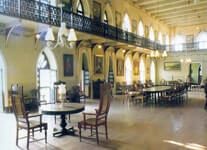One can check the credentials of this house. Legitimacy proven, one can look at your own reflection in the lancet windows of European style building on the right and face the Hindu temple set in a garden of roses up front. Clearly a house that takes you to an era when Goan Hindu aristocrats clung fiercely to their culture, lifestyle and moral fibre. A time when entertaining meant building a Guest House set apart from the main house. This house used to be called the Casa de Hospides or House of Hospitality. It reflects the unique social status of the Viscount of Pernem, a title held in perpetuity in the family. It was here that meat (pork but never beef) was cooked and served along with alcoholic drinks in banquets fit for kings with just one peculiar difference, the host never partook of these feasts. Each European official guest had a suite complete with valet, valet room and bathroom, a concept unthinkable in the main house. Inside the kitchens of the main house, the aristocrats sat upon low stools and ate a vegetarian meal in silence while their women waited upon them with customary docility.
If such a lifestyle is a confused mix of the traditional and the modern, a shattering of cultural barriers, the columns in the Guest House go a step further. Basalt slabs vie for space with Italian and French tiles on floors! Yet, in the main house, the Hindu pattern persists. This was the first home to have a telephone in Goa. They had their own reservoir and running water when such a thing was considered a miracle of sorts. Here, an impeccable rose garden forms an unfamiliar front-drop to the family temple on the left and the official guesthouse or the Casa de Hospides on the right sports the family monogram etched out on its lancet windows. This Guest House, was where the family entertained European beef-eating guests at banquets fit for princes in a Banquet Hall that is larger than any other in the whole of Goa. In a typical paradox, the Hindu hosts of the house did not eat with their European guests but welcomed them with characteristic warmth and then quietly retired to their traditional vegetarian kitchen where their own women served them with heads bowed in silence.
This arrangement of separating the guests from the main house was perhaps a mechanism to keep the womenfolk of the house cloistered and unexposed to the ways of the Western world. A case of architecture following the dictates of a traditional lifestyle. And yet, the family had ladies who could read and write in both Marathi and the Modu script in days when such a thing would have been considered unacceptable. The house also boasts of the first telephone in Goa, the first motorcar and the first piped water supply. The entrance hall was so vast that the temple elephant could be brought into it every year for a ritual that was the cynosure of the whole village. The furniture in the house was crafted by Christian carpenters for the use of an orthodox Hindu household and had cherubs and angels on the backrest albeit Indianised. The house is held seige today by outhouses, garages that showed off priceless vintage cars, stables that once housed horses and elephants and workshops that held court over carpenters, masons and painters that were once on the family payroll. Would one not be tempted to call such a house a palace then?


